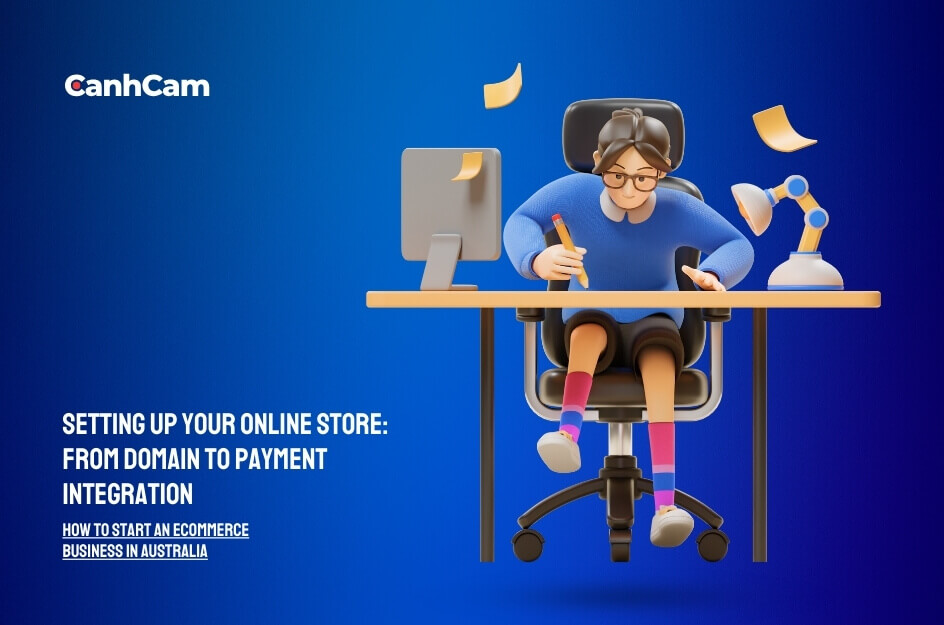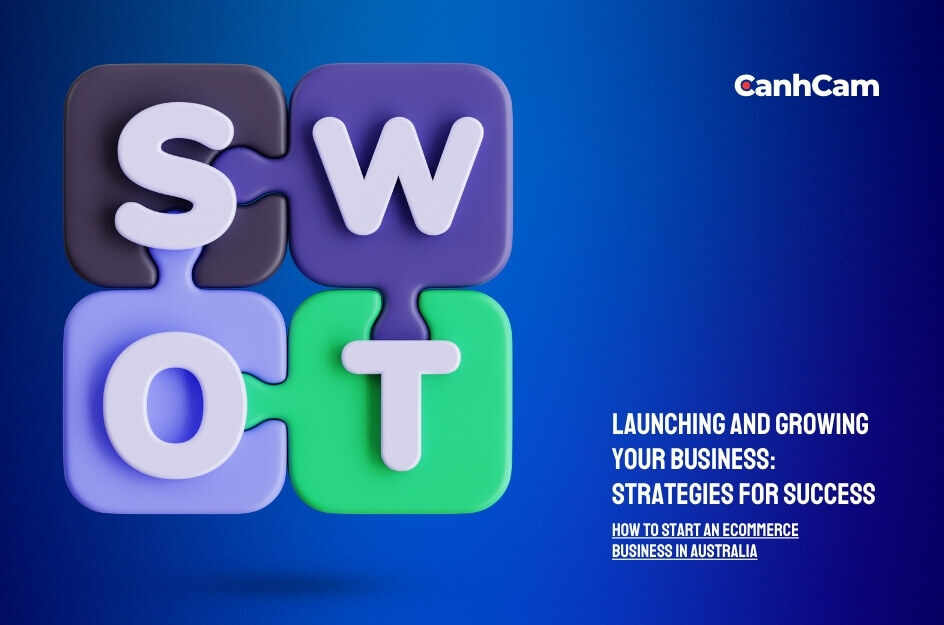How to Start an ecommerce business in Australia can be an exciting opportunity. With the growth of online shopping and its increasing convenience, now is a great time to take the leap and start your ecommerce venture.
However, before diving in, it's essential to have a clear plan and understanding of the steps involved. In this article, we will guide you through setting up an ecommerce business in Australia, from brainstorming ideas to launching your online store.
Benefits of Starting an Ecommerce Business in Australia
Setting up an ecommerce business in Australia has birthed several advantages that make it profitable and worth the investment. Some key benefits that will accrue include:
- Broad Market Reach: Ecommerce business allows for gaining a broad market reach. One is open to geographical limitations so that you can sell your products or services to customers across the globe.
- Lower Overheads: Ecommerce businesses have lower overhead costs than traditional ones based on bricks and mortar. From investing in a physical storefront and paying rent to hiring that much workforce, you don't have to. It can help you boost your profit margins.
- Flexibility and Convenience: ecommerce offers flexibility in working from anywhere. The store can be managed, the orders can be fulfilled, and customers are engaged from sitting at home or moving.
- Scalability: E-commerce business has high scalability. You will quickly introduce new products, access more customers, and make several sales as you grow your business without the limiting factors of having a physical store.
- Data-Driven Insights: E-commerce platforms have rich data and analytic capabilities to realize key customer behaviours, preferences, and market trends. This will help them make better decisions about optimizing marketing and improving performance in day-to-day business.
- E-commerce Tools and Resources: A long list of e-commerce platforms, tools, and resources is available in Australia to get you started and help you grow your business online. From website builders to payment gateways, there are several tools that you could leverage to enhance functionality and run the e-commerce business efficiently.
Build your website: Website Design and SEO Melbourne
Market Research and Niche Selection:
Before starting your ecommerce business, it's vital to research the market and choose the right niche in Australia.
Local insights are crucial due to varying consumer preferences. Understanding the Australian market helps identify profitable niches and consumer needs.
We will provide tailored strategies using Australian trend data and competitor analysis to pinpoint niche opportunities.
Learn how to spot market gaps, leverage trends, and understand popular product categories and payment methods among Australian online shoppers.
Knowing your target audience is critical for success, and we'll give you the knowledge to make informed decisions.

Read more: Guide to Google Analytics Enhanced Ecommerce
Setup and Legalities for Ecommerce Business in Australia:
1. Australian Business Registration: Your First Step
Every Australian ecommerce business needs an Australian Business Number (ABN). An ABN identifies your business to the Australian government and allows you to:
- Register for Goods and Services Tax (GST).
- Open a business bank account.
- Claim tax deductions for business expenses.
Here's how to obtain your ABN:
- Gather information: Prepare your Tax File Number (TFN) and any partner TFNs for your chosen business structure (sole trader, partnership).
- Apply online: Visit the Australian Business Register website (https://www.abr.gov.au/) and complete the application. It's quick and free.
- Receive your ABN: You'll receive confirmation and your ABN via email. Please keep it in a safe place for future reference.
Choosing a Business Structure:
The structure you choose will impact your legal and tax obligations. Here are some standard options:
- Sole Trader: This is the simplest structure, ideal for a single owner. For tax purposes, your business income is your income.
- Partnership: Suitable for two or more owners. Profits and losses are shared according to the partnership agreement.
- Seek professional advice: If unsure which structure best suits your business, consider consulting with an accountant or lawyer specializing in Australian business law.
2. Tax Implications: Understanding Your Obligations
Understanding Australian taxes for e-commerce businesses is crucial. Here's a breakdown of key taxes you may encounter:
- Goods and Services Tax (GST): Most e-commerce businesses in Australia must register for GST if their annual turnover exceeds $75,000. You must collect GST on your sales and lodge regular BAS (Business Activity Statements) with the Australian Taxation Office (ATO).
- Income Tax: You'll pay tax on your business profits after allowable deductions. The specific tax rate depends on your business structure.
Additional Resources:
The Australian Taxation Office website (https://www.ato.gov.au/) offers comprehensive information on business taxes.
Tips for Managing Your Finances:
- Keep accurate records of all your business income and expenses.
- Consider using accounting software to simplify expense tracking and tax filing.
- Set aside funds for future tax payments.
- Seek professional advice: An accountant familiar with e-commerce businesses can help you navigate tax complexities and ensure compliance.
3. Legal Considerations: Protecting Your Business
Operating legally protects you and your business. Here are some key areas to consider:
- Australian Consumer Law (ACL) protects consumers and outlines fair trading practices. Ensure your website and business practices comply with the ACL.
- Product Liability: Be aware of your responsibility for the safety of your products.
- Data Privacy: If you collect data from European Union customers, you must comply with Australian data privacy regulations and the General Data Protection Regulation (GDPR).
Choosing the Right Ecommerce Business Platform in Australia:
Selecting the right ecommerce platform lays the foundation for your online store's success. With various options available, it is essential to choose one that meets your specific needs and caters to the Australian market.
Understanding Platform Types:
Ecommerce platforms are the software solutions that power your online store. Here's a breakdown of the two main categories:
Hosted Platforms: These are user-friendly, all-in-one solutions. The platform provider handles hosting, security, and maintenance, making them ideal for beginners.
Examples include Shopify, Wix, and Squarespace.
- Advantages: Easy setup, affordable for basic needs, scalable plans for growth.
- Disadvantages: Limited customization, transaction fees, and less control over design and functionality.
Self-hosted platforms offer greater control by allowing you to install the software on your web hosting server. However, they require more technical expertise.
Popular options include WooCommerce (a WordPress plugin) and Magento.
- Advantages: Highly customizable and scalable, no transaction fees, full ownership and control.
- Disadvantages: Requires technical knowledge, higher initial setup costs, and responsibility for security and maintenance.
Top Australian E-commerce Platforms:
Now, let's delve into specific platforms, focusing on their suitability for Australian businesses:
Shopify is a user-friendly hosted platform with a wide range of features, apps, and integrations. It supports popular Australian payment gateways (Afterpay, Zip Pay) and is great for beginners and businesses with moderate needs.
- Pros: Easy setup, extensive app marketplace, strong mobile commerce features.
- Cons: Limited customization compared to self-hosted options, transaction fees for higher sales volumes.
WooCommerce: This self-hosted option seamlessly integrates with WordPress websites, giving you complete control over your store. It's cost-effective and flexible for businesses with some technical knowledge or access to developers. Integrates with popular Australian payment gateways.
- Pros: Highly customizable, no transaction fees, vast plugin ecosystem.
- Cons: It requires technical skills, developer costs, and additional security and maintenance responsibility.
BigCommerce is another leading hosted platform known for its scalability and robust features. It offers excellent SEO capabilities and built-in marketing tools, making it suitable for growing businesses with higher-volume needs. Consider pricing compared to other options.
- Pros: Scalable with advanced features, good for SEO and marketing, strong product management tools.
- Cons: Higher monthly fees compared to some competitors can be complex for beginners.
Additional Options:
Wix: A user-friendly platform suitable for simple online stores with basic needs. It offers a drag-and-drop interface for easy store creation. However, customization options are limited compared to other platforms.
Squarespace: Similar to Wix, Squarespace is user-friendly but lacks the extensive features of other platforms. Consider its limitations if you anticipate future growth or complex functionalities.
Tips from Australian Ecommerce Business Leaders:
Choosing the right platform is crucial. Learn from successful Australian ecommerce entrepreneurs who've navigated this journey:
- Focus on Australian-specific Features: Ensure the platform integrates seamlessly with Australian payment gateways (e.g., Afterpay, Zip Pay) and popular shipping providers (e.g., Australia Post, Sendle).
- Mobile-first Approach: Australians heavily use smartphones for shopping. Choose a platform optimized for mobile browsing and checkout experiences.
- SEO Optimization: Visibility in local search engines is vital. Look for platforms offering built-in SEO tools or easy integration with SEO plugins relevant to the Australian market.

Research is key! Identify a gap in the market and a product that suits Australian consumer trends.
Setting Up Your Online Store: From Domain to Payment Integration
With your platform chosen, it's time to set up your online store. Follow these step-by-step instructions tailored to the Australian user experience to ensure a smooth launch.
Choosing a Memorable Name:
- Relevance: Pick a domain name reflecting your brand and your products. (e.g., [canhcamagency.au] for a surf gear store)
- Australian appeal: Consider using the ".com.au" extension for a local feel and improved search ranking in Australia.
- Keep it short and catchy: Aim for 15 characters or less for easy recall and typing.
- Brandability: Choose a unique name with brand-building potential.
- Availability check: Use a domain registrar tool to confirm availability in both ".com" and ".com.au" extensions.
SEO Optimization: - Include relevant keywords: Integrate keywords Australians might use to search for your products. (e.g., "surfboards Australia" for the surf gear store)
- Avoid hyphens and underscores: They can make the name harder to remember.
Bonus Tip: Consider using a domain name generator tool to spark ideas that combine relevant keywords and brand elements.
Ecommerce Platform Setup:
Choosing Your Platform:
- Identify your needs: Consider technical skills, budget, and desired features.
- Research platform options: Explore platforms like Shopify, WooCommerce, BigCommerce, Wix, or Squarespace.
Platform Setup Walkthrough:
- Signing Up: Create an account with your chosen e-commerce platform.
- Store Design: Select a pre-designed theme or customize the layout to reflect your brand.
- Adding Products: Upload product information, including high-quality images, descriptions, categories, and pricing.
- Payment Gateway: Integrate a payment gateway like Stripe, PayPal, Afterpay, or Zip Pay to accept payments.
- Shipping: Configure shipping options and costs (consider popular Australian shipping providers).
- Taxes: Set up Australian tax rates (consult an accountant if needed).
- Payment Settings: Securely connect your payment gateway account.
Utilizing Resources:
- Most platforms offer detailed setup guides, tutorials, and video demonstrations. Leverage online support options or contact the platform's customer service for specific assistance.
- Product Uploads and Optimization: Showcase Your Products for Success
Compelling Content is Key:
- High-quality visuals: Invest in professional product photography or take clear, well-lit photos showcasing your products from multiple angles.
- Engaging descriptions: Write detailed and informative product descriptions that highlight features and benefits and target relevant keywords.
- Mobile-friendly presentation: Ensure your product pages display well on all devices, as many Australians shop using smartphones.
SEO Optimization for Australian Search Engines:
- Keyword research: Use Australian keyword research tools to identify relevant search terms for your products.
- Optimize titles and descriptions: Include targeted keywords in product titles and meta descriptions.
- Category organization: Organize products into clear categories and subcategories using Australian terminology. (e.g., "Beachwear" instead of "Swimwear")
Bonus Tip: To build trust and encourage conversions, offer customer reviews and ratings.
Payment Gateway Integration:
Popular Australian Payment Options:
- Integrate with popular Australian payment gateways: Offer options like Stripe, PayPal, Afterpay, and Zip Pay for a seamless checkout experience.
- Security is essential: Ensure your platform and payment gateway offer secure transactions and comply with Australian data privacy regulations (consider consulting an e-commerce specialist).
- Clear payment options: Display payment logos and explain how each payment gateway works for customer clarity.
Testing and Refinement:
- Test your checkout process thoroughly to ensure smooth payment processing.
- Consider offering guest checkout options for faster transactions.
Marketing and Customer Acquisition:
Marketing your e-commerce business effectively is essential for attracting customers and driving sales. Explore tailored strategies for reaching and engaging Australian audiences.
Define Your Target Audience:
Who are your ideal customers? Age, location, interests, and online behaviour (Australia-specific).
Tailor your marketing messages and branding to resonate with them.
Establish Your Brand Identity:
What makes your brand unique? Value proposition, personality, tone of voice.
Create a consistent brand image across all marketing channels to build trust and recognition.
Marketing Strategies for Australia:
Now you're ready to explore marketing channels tailored to the Australian market:
1. Leverage Facebook Marketplace:
Australians actively use Facebook Marketplace to buy and sell.
Create compelling listings showcasing high-quality product photos and clear descriptions.
2. SEO Best Practices for Australia:
Optimize your website for Australian search terms (e.g., include Australian location keywords in titles and meta descriptions).
Consider building backlinks from high-authority Australian websites.
3. Customer Acquisition Channels (Australia Focus):
Attract potential customers using these strategies relevant to the Australian market:
4. Google Ads Targeting:
Utilize Google Ads to target specific demographics in Australia.
Create targeted ad campaigns based on your ideal customer's interests and search behaviour.
5. Influencer Marketing:
Partner with Australian social media influencers relevant to your niche.
Leverage their audience reach to promote your products genuinely.
6. SEO Optimization for Australian Search Engines:
Optimize your online store to rank higher in Australian search results and attract organic traffic:
7. Local SEO:
Claim your Google My Business listing and optimize it with Australian location information.
Encourage positive customer reviews specific to your Australian audience.
8. Mobile Optimization:
Australians heavily use smartphones for online shopping.
Ensure your website is mobile-friendly for a seamless user experience.
9. Keyword Research:
Research popular search terms Australians use to find products in your niche.
Integrate these keywords strategically throughout your website content.
Shipping and Fulfillment:
Providing transparent shipping information and reliable fulfilment options is crucial for customer satisfaction and retention in the Australian market.
Here's why a transparent shipping policy is crucial for your Australian ecommerce business:
- Builds trust: Clear communication shows customers you respect their time and money.
- Reduces customer service inquiries: Customers know what to expect, minimizing questions.
- Improves conversion rates: Transparent costs can encourage purchases by avoiding hidden fees.
Popular Australian Shipping Options:
Australia offers a range of shipping solutions to get your products to customers quickly and efficiently. Here are some popular choices:
- Australia Post: The national postal service offers various options, from standard parcel post to express delivery.
- Sendle: An Australian-based courier service known for its competitive rates and focus on sustainability.
- Couriers (e.g., DHL, Toll): Ideal for time-sensitive or bulky items, offering faster delivery but potentially higher costs.
Choosing the Right Shipping Partner:
The best option depends on your business needs and customer preferences. Consider these factors:
- Cost: Find a balance between affordability and delivery speed.
- Delivery time: Prioritize faster delivery if your product demands it.
- Customer location: Offer options suitable for regional and remote areas in Australia.
- Fulfillment method: Consider shipping from your stock or drop shipping.
Streamlining Your Fulfillment:
Fulfillment refers to picking, packing, and shipping your orders. Here's how to optimize it for Australian customers:
- Accurate inventory management: Avoid delays by ensuring accurate stock levels.
- Efficient order processing: Use clear systems to quickly fulfil orders.
- Real-time order tracking: Provide customers with tracking information to ease their minds.
- Packaging for Australian conditions: Ensure your products are protected during transit.

Launching and Growing Your Business:
Launching your e-commerce business is just the beginning. Explore tactics for generating buzz, acquiring customers, and optimizing for growth in the Australian market.
Create a buzz:
- Promote your launch on social media.
- Email your audience.
- Offer limited-time deals to grab attention.
Guide to success: We'll show you how to create a launch plan that drives traffic and excitement.
Attract and Retain Customers:
- Go beyond launch: Discover strategies to attract new Australian customers and keep them returning.
- Content is king: Learn how to use content marketing to reach your target audience.
- Targeted ads: Explore effective paid advertising campaigns specifically for the Australian market.
Make Data-Driven Decisions:
- Track and analyze: Use analytics tools to understand your website traffic, customer behaviour, and sales.
- Data for improvement: Learn how to leverage data to optimize your marketing and make informed decisions.
- Enhanced experience: Use data to improve your store's user experience and increase conversions.
Test and Refine:
- Test different options: A/B testing lets you experiment with strategies and website elements to see what works best.
- Effective A/B testing: We'll show you how to conduct A/B tests to refine your marketing and improve results.
Maintaining Customer Loyalty: Building Relationships
Building trust and loyalty with Australian customers is essential for long-term success. Discover strategies for fostering lasting relationships and maximizing customer retention.
Delight Them Completely:
- Stellar Service: Go above and beyond for every customer. Australians appreciate a friendly, helpful approach.
- Personalized Touches: Remember names, preferences, and purchase history. Make them feel valued.
Keep Them Coming Back:
- Targeted Emails: Send personalized emails with special offers and product recommendations.
- Loyalty Programs: Reward repeat purchases with points, discounts, or exclusive deals.
Know Your Audience:
- Reviews Matter: Aussies trust reviews. Make it easy for customers to leave feedback and showcase positive ratings.
- Secure Payments: Offer trusted Australian payment options like Afterpay and Zip Pay.
Conclusion
As we conclude our guide, we hope you feel empowered to embark on your e-commerce journey in Australia. Success in this dynamic market requires diligence, adaptation, and a customer-centric approach.
Summarize the main steps covered in the guide, emphasizing the potential for success and the unique opportunities available in the Australian e-commerce market.
Reflect on the importance of market research, niche selection, legal compliance, platform choice, marketing strategies, customer acquisition, shipping and fulfilment, and maintaining customer loyalty.
Frequently Asked Questions:
To wrap up, let's address some common questions aspiring e-commerce entrepreneurs may have about starting a business in Australia.
1. What Does an Ecommerce Business Do?
An ecommerce business sells products or services online, typically through a website or marketplace.
2. What are the Different Types of Ecommerce Businesses In Australia?
Australia's e-commerce landscape mirrors the global trends, offering a variety of business models. Here's a breakdown of the common types you'll encounter:
Business-to-Consumer (B2C); Consumer-to-Consumer (C2C); Marketplace Model; Direct-to-Consumer (D2C)
3. Are Ecommerce Businesses Profitable?
Yes, e-commerce businesses can be highly profitable, but success depends on market demand, competitive landscape, and effective business strategies.
4. How Much Does it Cost to Start an Ecommerce Business in Australia?
The cost of starting an e-commerce business in Australia can vary depending on platform choice, product sourcing, and marketing expenses. However, starting with minimal investment and scale over time is possible.
- Low-cost approach (basic website, dropshipping): $1,000 - $5,000
- Mid-range approach (customizable website, some inventory): $5,000 - $20,000
- High-end approach (fully custom website, significant inventory): $20,000+
5. How do I Start a Small Ecommerce Business in Australia?
To launch your small e-commerce business successfully in Australia, follow the steps outlined in our guide, including market research, legal registration, platform selection, and marketing strategies.
6. What are The Essential Steps to Starting a Successful Ecommerce Business in Australia?
Key steps include:
- Identifying a profitable niche.
- Complying with Australian regulations.
- Choosing the right e-commerce platform.
- Implementing effective marketing strategies.
- Prioritizing customer satisfaction and loyalty.

